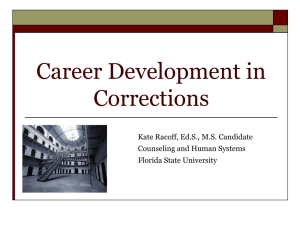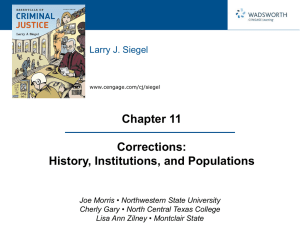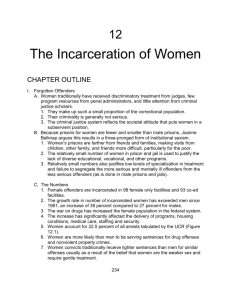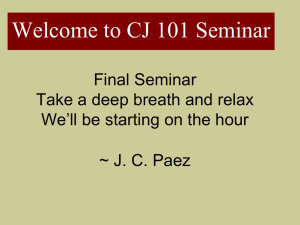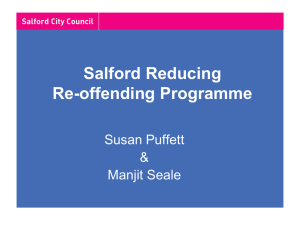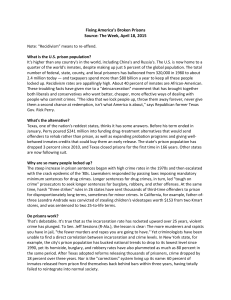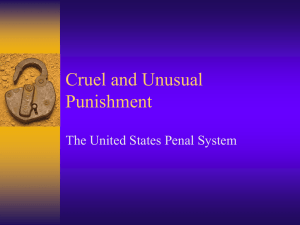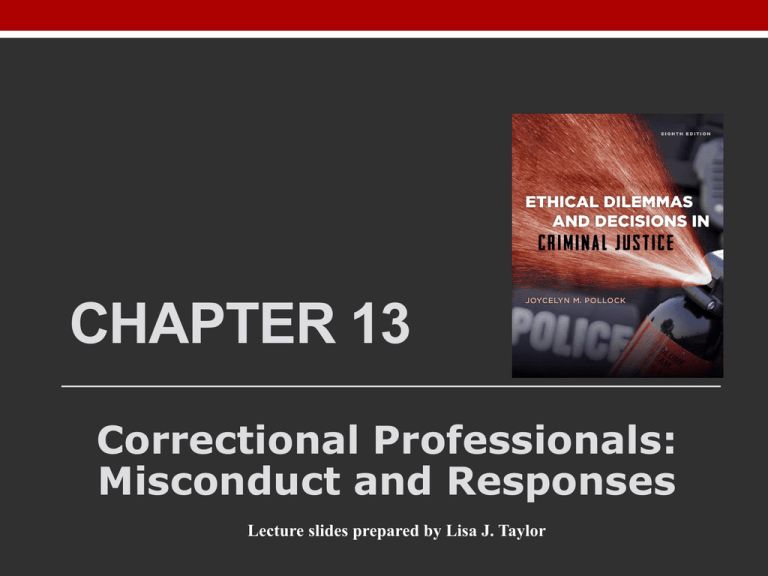
CHAPTER 13
Correctional Professionals:
Misconduct and Responses
Lecture slides prepared by Lisa J. Taylor
Corruption
• Bribery for access to legitimate activities
• Bribery to protect illicit activities
• Mistreatment/harassment/extortion of
inmates
• Gross mismanagement (e.g., prison
industries)
Corruption (Bomse)
• Malicious or purposeful abuse: excessive use of force;
rape and sexual harassment; theft and destruction of
personal property; false disciplinary charges; intentional
denial of medical care; failure to protect; racial abuse and
harassment; excessive and humiliating strip searches.
• Negligent abuse: negligent denial of medical care; failure
to protect, lack of responsiveness; negligent loss of
property or mail.
• Systemic or budgetary abuse: overcrowding; inadequate
medical care; use of isolation units
• Armstrong—a former guard at a
Prison
Guard
David
Armstrong
Colorado
(1999)
federal prison in Colorado—admitted
that he and other guards often beat
inmates to punish them for being
problematic.
• Armstrong later pleaded guilty to
conspiring to deprive inmates at the
Florence penitentiary in Colorado of
their right to be free from cruel and
unusual punishment.
• In a plea agreement, he implicated “at
least'' 10 former or current guards.
The group called itself “the Cowboys''
and beat inmates in multiple incidents
from January 1995 to October 1996.
The Prison Rape Elimination Act
(PREA 2003)
Mandated that every state keep a record
of prison rapes and allocated money to
study the problem and develop solutions.
Prison Rape
Elimination
Act
(2003)
•
Zero tolerance prison rape policy.
•
Makes the prevention of prison rape a top
priority in the prison system.
•
The National Institute of Corrections was
ordered to offer training and technical
assistance, provide a clearinghouse for
information and produce an annual report to
Congress.
•
Required the DOJ to create a review panel
designed to conduct hearings on prison
rape; this panel was given subpoena power
as well.
•
Authorized the Attorney General to
dispense grant monies to facilitate
implementation of the act. These grants are
administered by the Bureau of Justice
Assistance and the National Institute of
Justice.
Abu Ghraib in the U.S.?
•
Gladiator fights in Corcoran Prison
•
The “Tucker telephone” in Arkansas
•
Using “dog boys” as live quarry for Texas dog handlers
•
Beatings and the use of dogs on prisoners
•
Looking the other way while inmates beat and raped a victim
•
Inmates being forced to wear pink underwear as punishment
•
Inmates being stripped as punishment
•
Inmates being made to wear black hoods
Thinking
Point
The California Department of Corrections has
been implicated in a series of inappropriate
behaviors towards inmates. In May of 2010,
several California state senators demanded
Governor Arnold Schwartzenegger begin an
investigation in multiple reports of prison
corruption. According to accusations, correctional
officers withheld medical care, participated in
using racial slurs, and punished correctional
officers who reported unethical behavior.
What implications may occur if the Governor
decides to investigate? What may occur, if he
does not?
Is such behavior commonplace in many
prisons?
Can it be prevented?
Community Corrections
• Most offenders are under some form of
community supervision.
o probation or parole
o halfway houses
o work release centers
o community-based correctional facilities (CBCF’s)
o intermediate sanctions
Community supervision poses different ethical
challenges than institutional corrections.
The Zimbardo Experiment
•
In the 1970s, a mock prison was set up in the basement of a
building on the grounds of Stanford University.
•
College men were arbitrarily assigned to be guards or inmates.
•
Many of the “guard” subjects became brutal toward the
“inmate” subjects.
•
Many of the “inmate” subjects became docile and submissive.
•
Behavioral changes in both groups were so profound that the
experiment was canceled after six days.
•
The study illustrates the profound effect of a prison experience.
Reducing
the Culture
of Violence
in Prisons
The Commission on Safety and Abuse in
American Prisons developed the
following list of recommendations to
reduce the “culture of violence” in
prisons:
•Improve staffing levels, hiring, and
training
•Provide independent oversight for
complaints and investigations of
misconduct
•Increase access to the courts.
•Increase the level of criminal
prosecution of wrongdoers.
•Strengthen professional standards
Management and Unions
• Have been successful in some states in
obtaining greater benefits for their members.
• Have not been especially effective at
promoting professionalism and ethics among
their members.
Management Ethical Goals
•
Treat staff fairly and impartially
•
Make merit-based promotions
•
Show no prejudice
•
Lead by example
•
Develop a clear mission statement
•
Develop a code of ethics that is a list of “dos,” not a list of “don’ts”
•
Create a performance-based culture, not a seniority-based culture
•
Solicit staff input on new policies
•
Be respectful
•
Create an culture that values ethical behavior
A New Corrections Paradigm?
• America has one of the world’s highest rates of
incarceration.
• High recidivism rates suggest that prisons and
other deterrence mechanisms are not
particularly effective in reducing crime.
• Some advocate a new approach to crime and
punishment.
Restorative Justice Goals
• Meeting a clearly defined and obvious need.
• Symbolically linking offender and victim, or
offender and community.
• Viewing offenders as resources, with outcome
measures directed to the work itself, rather than to
the offender's behavior.
• Involving offenders in project planning and
execution.
• Achieving a sense of accomplishment, closure,
and community recognition.
Restorative Justice Goals
Sentencing circles or healing circles: offender meets with
the victims, family and others; the group determines sanction.
Victim-offender mediation: brings victims face-to-face with
their offenders so the victims can tell the offenders how being
victimized affected them.
Community reparative boards: seeks to devise sentences
that meet the needs of both parties.
Victim education: similar to victim-offender mediation, does
not match victims with their particular offenders, but instead
uses volunteer victims to meet with offenders and explain the
effects victimization had on them.
Shaming
Reintegrative and Stigmatizing
A variety of punishments inflicted on offenders today
incorporate the concept of shame.
•
Some convicted of drunk driving must obtain special
license plates.
•
Some sex offenders must post signs on their houses.
•
Some offenders have been required to publicly
confess and seek the forgiveness of their community.
•
Sex offender registries (have led to offenders being
injured or killed in a few instances)
Forgiveness
• Should only victims be able to give
forgiveness?
• Is it possible to be too forgiving?
• What is the ethical justification for
forgiveness?
• Is it wrong not to forgive?

